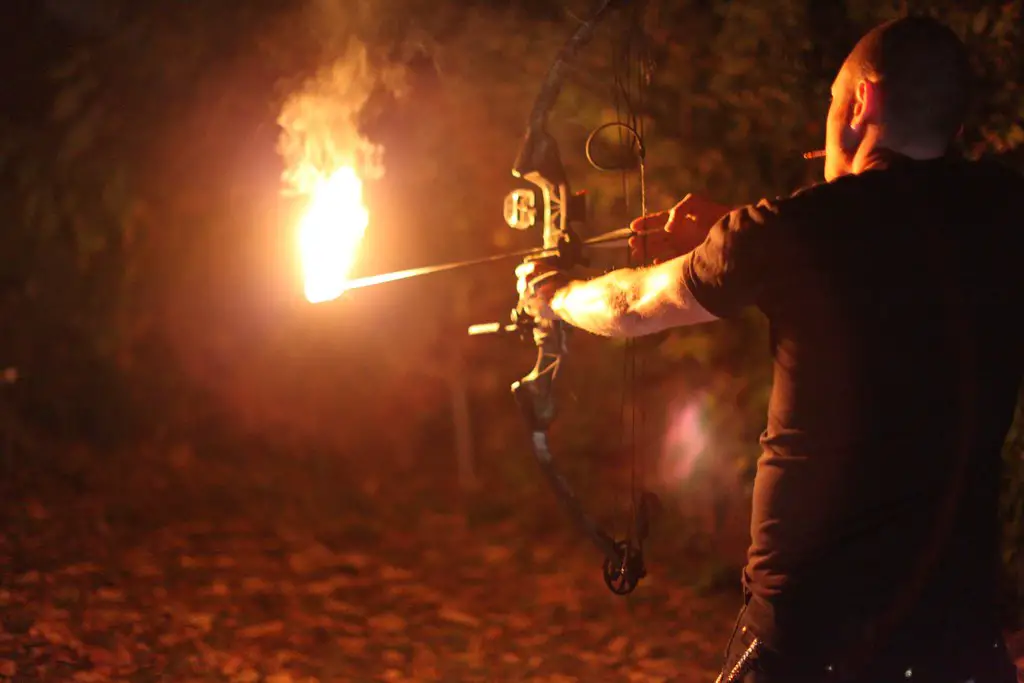The use of fire arrows dates back to the earliest history of warfare, as early as the 3rd century BC. They were widely used in the Middle East, Europe and China until the first century AD.
To make fire arrows, people used to use pitch – primarily made from pine tar or sap – which was wrapped around the arrow shaft. The pitch would be ignited with a piece of string or cloth. The shafts were made from bamboo or other woods.
The arrows were sometimes also fitted with metal heads and were stored in special cases. They could be fired using any bow and were used for signaling as well as for setting buildings on fire.
While the technology has evolved since then, the basic principles remain the same – and with a few supplies, you can make your own arrows that burst into flame.
Once you get started, there are lots of ways to customize your fire arrows by experimenting with different materials.
Pine Pitch
To make fire arrows, people used to use pitch. Pitch is a sticky substance similar to tar, and it can be found naturally in some pine trees.
To get the pitch, you had to cut the tree down and then chop the stump into pieces. From those pieces, you could easily extract the pitch. If you’re just out in the woods, look for scars or injuries in pine trees. These often will send out sap.
Pitch is waterproof, so it was perfect for making fire arrows. The process was simple: You just had to dip the arrows in melted pitch and let them dry.
To make fire arrows, you need something flammable. The simplest choice is a cloth rag, which can be lit on one end and used as a fuse to light the arrowhead. Use a piece of string or twine to tie the rag around the shaft just below the arrowhead.
You’ll also need something else to light it with. If you have a standard lighter, that’s easy enough. You can also use matches or a magnifying glass. Finally, you’ll need an arrowhead that can hold a flame for long enough to carry the fire downrange to your target.
- Attach your flammable material to the end of your arrow using a rubber band, string or tape. If you’re using tape, avoid masking tape or duct tape, which could catch on fire and burn your hand. Instead, use electrical tape or another type of flame-retardant tape. Flammable material is usually some sort of rag or cloth. Depending on how long you want the arrow to burn, and on how sticky your pitch or flammable stuff is, this may be optional.
- Find an ignition source that’s safe for use with the flammable material attached to your arrow. Lighter fluid and other petroleum-based fuels require a match or a propane torch to ignite them; cloth needs only an ember from a campfire or other source of heat.
- Aim at the target and light the arrow carefully — don’t make contact with the flaming part of the arrow until it’s safely out of your bow — then release it and watch where it lands.”
PVC Glue for Fire Arrows
PVC Pipe cement is a similar consistency as pitch, and its extremely flammable. Right on the label it has a caution for being “Highly Flammable.” As a pyromaniac teenager I put this to the test and was not disappointed. Since then, its been my go to substance for making fire arrows. I’ve had the best success with pipe cement, and it has a nice applicator built into the lid, so you can keep the sticky flammable stuff off your hands.
PVC Pipe Cement

Keep Learning
Prepping is an ongoing venture. Because of this, we recommend that you subscribe to our bimonthly newsletter to keep prepping, emergency preparedness, and self reliance on your mind. We promise, we’re not spammy, which is why we only email you twice per month. We hope you think about being prepared more than twice per month, but our newsletter is a valuable resource to help you learn new things, and just to keep prepping on your mind. Right now you can also sign up for free. You can also follow our Facebook Page for regular articles and resources.

